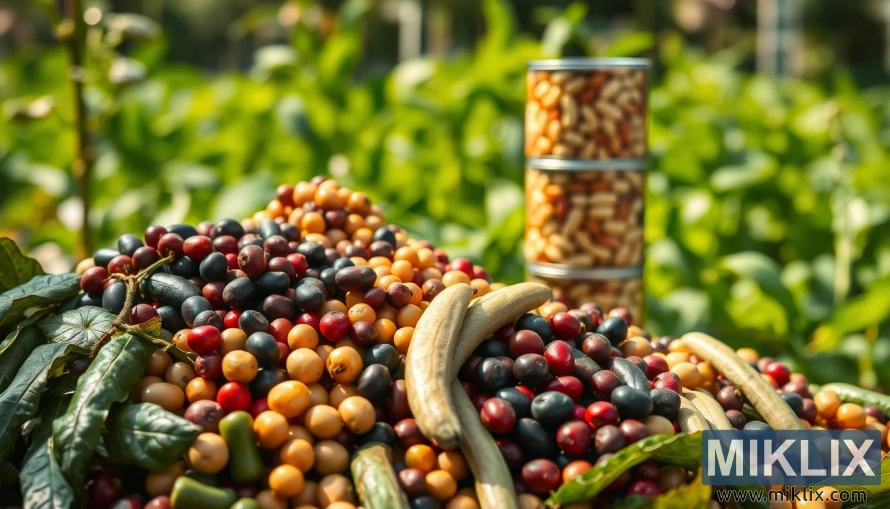Image: Affordable Sustainable Beans
Published: May 15, 2025 at 11:44:47 AM UTC
Last updated: September 24, 2025 at 8:17:52 PM UTC
Fresh beans with canned varieties set against a lush farm scene, highlighting beans as a sustainable, nutritious, and cost-effective protein source.
The image presents a vibrant and dynamic celebration of beans, captured in a way that emphasizes their abundance, diversity, and essential role in both human diets and sustainable agriculture. In the foreground, a generous heap of freshly harvested beans dominates the frame, their colors spanning a striking spectrum—from glossy black and deep burgundy to pale cream, golden yellow, and rich earth tones. Their varied shapes and sizes highlight the natural diversity of legumes, with some beans small and spherical, others slightly elongated, and all brimming with vitality. Interspersed among the pile are a few fresh pods, curved and firm, reminding the viewer of the beans’ direct connection to the soil and the plants that produced them. The addition of scattered green leaves enhances this sense of freshness, grounding the harvest firmly in its natural origins.
Moving slightly back in the composition, a neatly stacked tower of containers filled with beans provides a striking contrast to the raw, organic pile in the foreground. The glass jars, aligned with precision, symbolize the accessibility and practicality of beans as a pantry staple. They capture the way beans can move seamlessly from farm to kitchen, remaining affordable and versatile at every stage. This middle-ground element highlights not only the convenience of preserved beans but also their reliability as a cost-effective protein source that can be enjoyed year-round, regardless of harvest cycles. The juxtaposition of freshly picked beans with their packaged counterparts suggests a continuum of nourishment, one that spans from cultivation in fertile soil to preparation in the home.
The background of the image completes the story with a lush, green agricultural landscape. The blurred but discernible rows of plants suggest a thriving garden or farm setting, a reminder that beans are deeply rooted in the rhythms of sustainable agriculture. The natural lighting, soft yet bright, illuminates the entire composition with warmth, enhancing the rich colors of the beans and casting a gentle glow that evokes the feeling of a sunny day in the fields. This sense of openness and vitality reinforces the connection between human health and the health of the land, underscoring the idea that beans represent not only nourishment for people but also resilience for ecosystems, thanks to their ability to enrich soil through nitrogen fixation.
The overall mood of the photograph is one of abundance, accessibility, and wholesomeness. It conveys a clear message about the practicality of beans as a cornerstone of plant-based nutrition. As one of the most affordable sources of protein, beans offer a sustainable alternative to animal-based foods, making them vital not just for personal health but also for global food security and environmental sustainability. Their versatility in the kitchen—whether simmered into stews, tossed into salads, blended into spreads, or simply enjoyed on their own—adds to their appeal, ensuring that they remain a staple across cultures and cuisines. By bringing together images of fresh harvests, packaged convenience, and lush agricultural settings, the photograph encapsulates the full story of beans: humble yet powerful, economical yet nourishing, rooted in tradition yet indispensable for the future.
The image is related to: Beans for Life: The Plant-Based Protein with Perks

